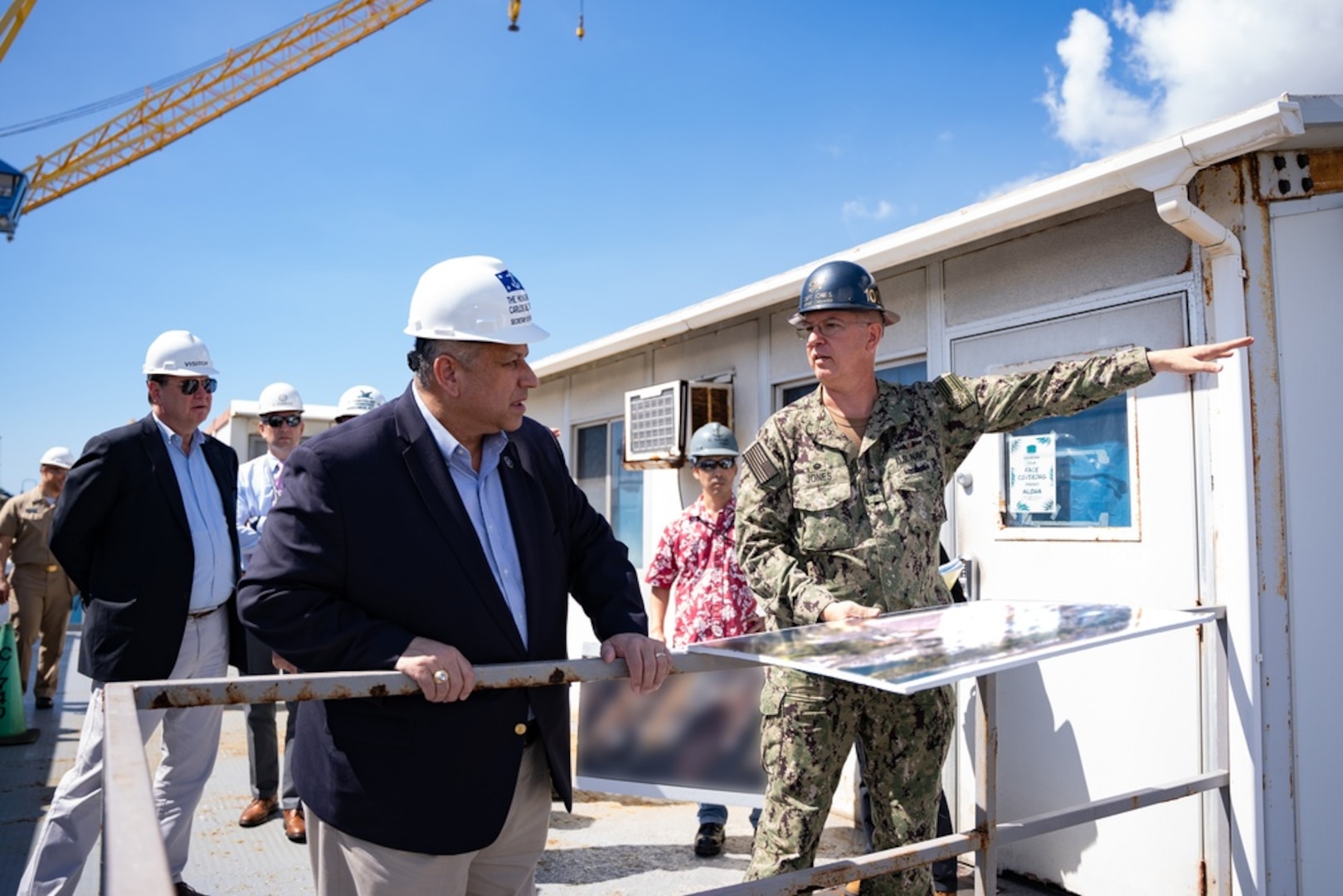JOINT BASE PEARL HARBOR-HICKAM, Hawaii – Secretary of the Navy Carlos Del Toro visited the Pearl Harbor Shipyard and Intermediate Maintenance Facility (PHNSY and IMF) Feb. 27 to discuss the Shipyard Infrastructure Optimization Program (SIOP) with the Naval Shipyard and Naval Installations Engineering Systems Command (NAVFAC), Pacific Branch.
SIOP will improve efficiencies needed at the U.S. Navy’s four public shipyards to ensure the fleet is ready to support the nation’s national security mission by synchronizing with current efforts to improve labor productivity. work, processes and procedures. By modernizing infrastructure and industrial plants to provide the availabilities needed for strategic competition, shipyards will be able to support the surge capacity needed for operational and global events.
“SIOP in our shipyards is a top priority for my office,” Del Toro said. “PHNSY & IMF is the second shipyard I have visited since my confirmation and seeing firsthand the need for infrastructure improvements further reinforces my commitment to the SIOP initiative. The level of maintenance work carried out here every day is often challenged by aging facilities and equipment Every shipyard worker recognizes that every ship and submarine undergoing necessary maintenance and modernization must be returned to the fleet on time, every time to hold off our adversaries To achieve this, we must provide our shipyard workforce with the necessary upgraded facilities, tools and equipment.”
The Navy’s four public shipyards are the backbone of our nuclear-powered fleet and essential elements of our national defense strategy. While still burdened by an uninterrupted schedule of maintenance availability on our fleet of ships and submarines, their performance has been undermined by aging conditions, configurations and locations of support facilities, dry docks and equipment. .
Originally designed and built in the 19th and 20th centuries to support wind and steam-powered ships, the Navy’s public shipyards are currently not effectively configured to maintain and modernize a nuclear-powered fleet. These inefficiencies along with outdated facilities lead to higher maintenance costs and delayed schedules. SIOP will renovate and reconfigure public shipyards with the 21st century industrial technology our workforce needs through integrated infrastructure investments.
While SIOP is a high priority for the Navy, members of Congress have also thrown their support behind this key initiative that will further strengthen the Navy’s ability to respond to global events at any time. Over the past several months, PHNSY & IMF has hosted numerous congressional and staff delegations to highlight the important work of the Navy’s maintenance community and show the need to modernize infrastructure and facilities at the century-old shipyard.
“Since the shipyard was established in 1908, there have only been two periods of modernization – to support operations during World War II and again after the Korean War to support the launch of the nuclear-powered navy from our country,” said Captain Richard Jones, Commanding Officer of the shipyard. “SIOP will give us the opportunity to continue supporting our mission of keeping the U.S. Pacific Fleet combat ready by providing our personnel with new and improved facilities to support the next generation of Virginia-class submarines. “
Drydock recapitalizations must be completed to provide the necessary capacity for current and future platforms – accommodating future Virginia-class submarine configurations at PHNSY & IMF and Portsmouth Naval Shipyard and Ford-class aircraft carriers at Norfolk Naval Shipyard and Puget Sound Naval Shipyard and Intermediate Maintenance Facility.
For PHNSY & IMF, the need for a new drydock is of critical importance as drydock 3 will become obsolete at the end of 2023. With an expected date of need of 2028, drydock 5, as can be l ‘call, is nearing completion. of its environmental impact statement (EIS). The EIS is the culmination of more than three years of research, planning, and coordination by the U.S. Navy and our local, state, and federal partners to provide the best design alternatives for a new drydock with the least impact on the ‘environment.
“As PHNSY & IMF is Hawaii’s largest industrial employer, we also have strong historical and cultural ties to the community,” Jones said. “Working closely with our local partners, we will continue to honor Pearl Harbor’s important legacy.”
The Navy recently hosted a virtual public meeting on February 24 to receive input from the local community on how proposed project alternatives might impact the local environment. The public is invited to comment on the draft EIS until March 21. To learn more about the project and make an official comment, visit the project website at www.pearlharbordrydockeis.org.
PHNSY & IMF is a Naval Sea Systems Command field activity and one-stop regional maintenance center for Navy surface ships and submarines. It is the largest industrial employer in the state of Hawaii. It is the most comprehensive fleet repair and maintenance facility between the US West Coast and the Far East, strategically located in the heart of the Pacific, approximately one week sailing time closer to potential regional contingencies in the Indo-Pacific.
For more information on Pearl Harbor Naval Shipyard and IMF, visit navsea.navy.mil/Home/Shipyards/PHNS-IMF or facebook.com/PearlHarborNavalShipyard.

